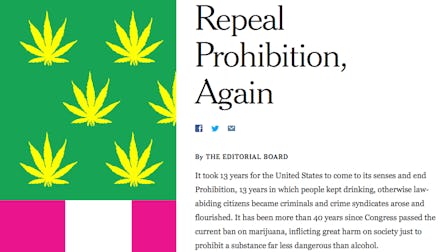The Alarming Statistic That Spurred the New York Times' Defense of Marijuana Legalization

And here it is:
Image Credit: The Uncovery
The racial bias of marijuana arrests is one of the New York Times editorial board's key arguments for repealing prohibition.
The logic is simple. In the 40 years since the current ban was enacted, black and white Americans have used cannabis at comparable rates:
Image Credit: Vox
Yet blacks disproportionately shoulder the legal burden, as indicated by the striking disparity in arrest and incarceration figures over the past few decades:
Image Credit: Vox
Meanwhile, the danger of cannabis as a substance has never been proven, especially compared to legal drugs like tobacco and alcohol:
Image Credit: WHO
These disparities all but debunk the law's legitimacy as a matter of public good.
Background: The pro-legalization movement has gained incredible momentum in recent years.
To date, both Colorado and Washington have legalized recreational marijuana use for adults over 21, while nearly 75% of U.S. states have either decriminalized it, legalized medical use or reduced penalties for possession.
Image Credit: New York Times
But the movement scored one of its biggest ideological victories on Saturday, when the New York Times became the largest American news publication to officially endorse legalization.
Image Credit: New York Times
In an impassioned 500-word treatise, the Times editorial board compared modern cannabis bans to the ills wrought by Prohibition in the 1920s, concluding that, despite its logistical complexities, "the balance falls squarely on the side of national legalization… on nearly every level."
The Times will build its case for legalization over the next two weeks, with a six-part series unraveling the history and modern iterations of marijuana prohibition. The last entry will be published Aug. 6.
Meanwhile: The damage wrought by the law's racism remains impossible to deny.
It's apparent that racial bias was inscribed in prohibition rhetoric from its inception. A notable example is Marihuana Tax Act of 1937 architect Harry Anslinger, who was quoted saying,
"Colored students at the University of Minnesota partying with female students (white) smoking and getting their sympathy with stories of racial persecution. Result, pregnancy."
But: Only in the era of mass incarceration did prohibition become such a major statistical juggernaut. Michelle Alexander pioneered its characterization as a race war with her 2010 book The New Jim Crow, where she outlines how modern drug laws trap (mostly) young black men in an inescapable cycle of disenfranchisement, unemployment and imprisonment.
Vox recently published a breakdown of how this plays out in marijuana laws and the War on Drugs overall. Among its claims are that mandatory-minimum sentencing still unfairly targets substances used by blacks more than whites:
Image Credit: Vox
Black drug offenders also receive jail sentences 13.1% longer than white offenders for the same crimes.
The takeaway: Exposing these disparities is important for challenging the myth that marijuana prohibition is here to benefit the public. As a means of social control and oppression, it's clearly an effective weapon. But when it comes to supporting general health and liberty, the verdict is just as troubling:
Bad for everyone. Worse for black people.